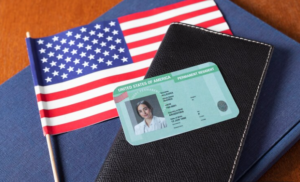Reentering the U.S. on an Expired Visa with Valid I-94

Introduction
Numerous visitors to the United States are left wondering if they can return to the country if their visa has expired but their I-94 is still active. The response isn’t always simple, and missteps can result in denial of entry, status violations, or even immigration bans. This blog provides a detailed examination of what you should know about reentering the U.S. with a valid I-94 but expired visa, including the legal risks, options, and real-life situations that affect nonimmigrant visitors.
1. Understanding the Basics: Visa vs. I-94

A visa is a certificate provided by U.S. embassy or consulate permitting an overseas national to seek entry to the United States. Upon your admission, Form I-94 is made into the governing document determining how long you may stay lawfully. Here confusion normally begins.
The visa is for entry, not residence. Once you’re inside the U.S., whether the visa has expired is irrelevant—so long as your I-94 expiration date hasn’t yet come. But if you travel outside the U.S., you won’t be allowed back in on an expired visa, even if your I-94 date of expiry hasn’t yet occurred.
It is important to understand this difference. Your visa and your I-94 have different purposes, and one cannot be substituted for the other when it comes to re-entry.
2. Scenario Breakdown: Expired Visa but Valid I-94
Let’s deconstruct the case of having a valid I-94 but an expired visa. What this is saying is that the traveler is legally within the country and their presence is approved, but if they ever leave—even just to visit somewhere else for a day or two—their visa has expired and they cannot return unless they renew it.
It’s prevalent among nonimmigrant employees (such as H1B workers) and students (F1 visa recipients), particularly those who have spent many years in the U.S. Even though they may have a valid foreign passport with a valid visa and I-94 when they arrive, the visa could become invalid while they are in the country and the I-94 is still valid.
Unfortunately, the I-94 is not a reentry privilege document. Reentry using only a valid I-94 and no valid visa will lead to denial of boarding by the airline or denial of entry by CBP officers at the port of entry.
3. Legal Requirements for Reentry to the U.S.

To be legally able to reenter the United States, you should have:
- A valid passport.
- A valid U.S. visa is in the right category.
- A valid, legitimate reason for reentry.
The I-94 has no role in the reentry process. It only takes effect after you’ve been allowed into the country. If your visa is expired—even if the expiration date on the I-94 hasn’t passed—you cannot use the I-94 for travel purposes.
Individuals mistakenly equate their ongoing legal presence with eligibility for travel. You may comply with your stay requirements but departing the U.S. on an expired visa and hoping to reenter only with a current I-94 can result in significant issues upon arrival.
4. What Does It Mean if You Attempt to Reenter on an Expired Visa?
Attempting to return to the U.S. with no valid visa—even with a valid I-94—will virtually always lead to:
- Denied boarding at the airport, particularly by carriers that check documents before boarding a U.S.-bound flight.
- Refusal of admission at a U.S. port of entry by the Customs and Border Protection (CBP).
- In exceptional situations, expedited removal or termination of existing I-94 records.
Returning under such circumstances might also alert immigration officials, as it would be interpreted as a misinterpretation of legal status or even an effort to manipulate visa rules.
5. The Automatic Revalidation Rule (Reentering Without a Valid Visa)
There is a single significant exception that’s beneficial to most travelers: Automatic Visa Revalidation (AVR). This rule permits specific travelers to return to the U.S. for brief visits (under 30 days) to Mexico, Canada, or specific Caribbean islands without having to renew their expired visa, as long as they satisfy certain requirements.
Requirements for AVR are:
- Possessing an expired nonimmigrant visa.
- Having a valid I-94.
- Not seeking a new visa abroad.
- Only traveling to visa-eligible countries (e.g., Mexico or Canada).
- Having an AVR-eligible status (e.g., F, J, H, L).
Even visitors with valid I-94 but expired visas can return without reapplying for a new visa—but only according to AVR regulations. This rule doesn’t cover visitors from all countries or those who’ve requested a new visa while traveling abroad.
6. When and How to Renew Your Visa for Reentry

If you wish to return to the U.S. after your visa has expired, the only safe method is to renew your visa at a U.S. embassy or consulate abroad. This involves:
- Filing Form DS-160.
- Scheduling a visa appointment.
- Participating in an in-person interview (if eligibility requires it).
- Waiting for visa issuance (processing times are highly variable).
Unfortunately, you cannot renew a visa from within the United States. Even if your I-94 renewal reentry status is approved by other means (e.g., USCIS), it won’t assist with border reentry unless the visa itself is renewed.
7. Risk of Overstay and Unlawful Presence
One of the most significant dangers here is misreading which document regulates your legal status. If your i-94 expired but i-797 is valid, you might have been given an extension of status but not left and re-entered to have a new I-94.
However, a visa valid but I-94 expired is a risky status—because you’re no longer in valid status and could be gaining unlawful presence. Overstaying your I-94 can lead to:
- 3-year or 10-year reentry bars.
- Ineligibility for future visas or adjustment of status.
It’s advisable to always check your I-94 expiration date online via the CBP’s official portal and do something before it expires. Either mismanaging your visa or I-94 can result in severe implications.
8. Special Considerations by Visa Type
Various types of visas have unique reentry and I-94 regulations.
F-1 Visa (Students)
F-1 holders enter with D/S rather than a definite i-94 date of expiry. They are allowed to remain in the country while retaining student status. However, after the expiration of the visa, they have to obtain a new one in order to reenter—despite the valid visa with I-94 status that applied before.
H1B, L1, O1 (Workers)
Often, workers face i-94 expired but i-797 is valid situations after USCIS approves extensions. Though they remain in valid status, they must leave and reenter to get a new I-94. I-94 renewal reentry requires valid documents at the border.
B1/B2 (Visitors)
If your visa is valid but I-94 expired, you are not in status. Reentry in the absence of a valid visa or I-94 is forbidden and can cause bans for being in unlawful presence.
10. Pre-Flight Tips When Flying with an Expired Visa

If you want to leave the U.S. while your visa is expired but your I-94 is not, here’s what you should do:
- Verify your I-94 status online using the official CBP I-94 portal.
- Ensure that you’re not mixing up a valid I-797 extension with a renewed visa.
- If you have a visa valid but the I-94 expired, seek immigration advice right away—you’re probably out of status.
- If your i-94 expires but your visa is valid, you can’t legally remain and are gaining unlawful presence.
- For individuals with legal status but with expired visas, organize your trip only after renewing your visa overseas.
- Don’t rely solely on automatic visa revalidation unless you’re 100% sure you’re eligible.
Remember: border agents will only let you in with a valid visa. Your I-94 will be issued anew on entry—it has no authority outside U.S. borders.
Still Unsure About Your Visa or I-94 Status?
Don’t risk your future with outdated documents. At Passage Law our lawyers make tough immigration questions easy—schedule a strategy call today and proceed with confidence.
